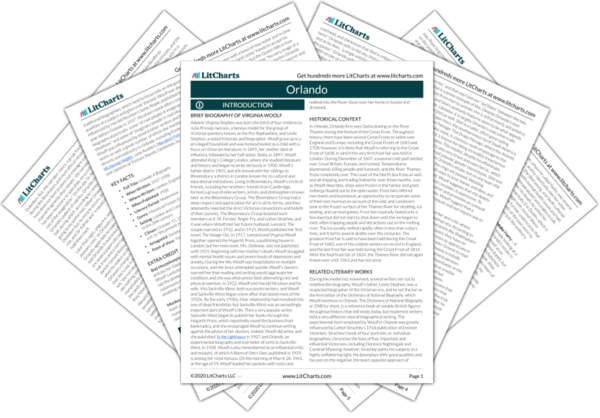Clothing symbolizes the artificiality of gender as a social construction in Virginia Woolf’s Orlando, and it often serves to obscure one’s true gender identity, which the novel suggests naturally vacillates between both male and female. Orlando’s gender identity, both as a man and as a woman, is communicated and represented through clothing. After Orlando transforms from a man into a woman, the narrator is careful to note that nothing else much changes in Orlando’s appearance. “Their faces remained, as their portraits prove,” the narrator says, “practically the same.” When Orlando wears trousers, he is perceived by others as a man. Conversely, when Orlando wears a dress, she is perceived by others as woman. Thus, the novel suggests, it is Orlando’s clothes, not Orlando’s body, that dictates Orlando’s gender.
The same is true for other characters in the novel who find themselves pigeonholed into certain gender identities based on which gender their clothes suggest they are. For instance, when Orlando first sees Sasha skating on the ice during the Great Frost, her masculine Russian clothes make Orlando believe she is a man; and when the Archduke Harry puts on a dress and disguises himself as the Archduchess Harriet, Orlando believes he is a woman even though he is rightly a man. The narrator even points out how the popular style of dress during the 16th century, which is quite elaborate and feminine even for the men’s fashions, obscures Orlando’s then-male gender. “Clothes are but a symbol of something hidden deep beneath,” the narrator argues. The novel posits that everyone has both male and female qualities and that no one is wholly one gender or the other—after all, “often it is only the clothes that keep the male or female likeness, while underneath the sex is the very opposite of what it is above.”
Clothing Quotes in Orlando
But there, sitting at the servants’ dinner table with a tankard beside him and paper in front of him, sat a rather fat, rather shabby man, whose ruff was a thought dirty, and whose clothes were of hodden brown. He held a pen in his hand, but he was not writing. He seemed in the act of rolling some thought up and down, to and fro in his mind till it gathered shape or momentum to his liking. His eyes, globed and clouded like some green stone of curious texture, were fixed. He did not see Orlando. For all his hurry, Orlando stopped dead. Was this a poet? Was he writing poetry? “Tell me,” he wanted to say, “everything in the whole world”—for he had the wildest, most absurd, extravagant ideas about poets and poetry—but how speak to a man who does not see you ? who sees ogres, satyrs, perhaps the depths of the sea instead?

Unlock explanations and citation info for this and every other Orlando quote.
Plus so much more...
Get LitCharts A+With some of the guineas left from the sale of the tenth pearl of her string, Orlando had bought herself a complete outfit of such clothes as women then wore, and it was in the dress of a young Englishwoman of rank that she now sat on the deck of the Enamoured Lady. It is a strange fact, but a true one that up to this moment she had scarcely given her sex a thought. Perhaps the Turkish trousers, which she had hitherto worn had done something to distract her thoughts; and the gipsy women, except in one or two important particulars, differ very little from the gipsy men. At any rate, it was not until she felt the coil of skirts about her legs and the Captain offered, with the greatest politeness, to have an awning spread for her on deck that she realized, with a start the penalties and the privileges of her position. But that start was not of the kind that might have been expected.
The difference between the sexes is, happily, one of great profundity. Clothes are but a symbol of something hid deep beneath. It was a change in Orlando herself that dictated her choice of a woman’s dress and of a woman’s sex. And perhaps in this she was only expressing rather more openly than usual—openness indeed was the soul of her nature—something that happens to most people without being thus plainly expressed. For here again, we come to a dilemma. Different though the sexes are, they intermix. In every human being a vacillation from one sex to the other takes place, and often it is only the clothes that keep the male or female likeness, while underneath the sex is the very opposite of what it is above. Of the complications and confusions which thus result every one has had experience; but here we leave the general question and note only the odd effect it had in the particular case of Orlando herself.












